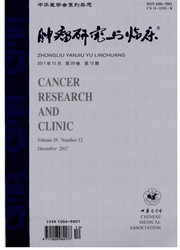

 中文摘要:
中文摘要:
目的研究骨髓间充质干细胞(MSC)诱导肿瘤发生的机制。方法用荧光差异显示技术(FDD)寻找差异基因;PCR、免疫组织化学、Western blotting加以验证;实时荧光定量反转录聚合酶链反应(Realtime RT—PCR)检测诱导致瘤细胞在裸鼠体内致瘤后致瘤组织的基因表达水平。结果FDD结果显示Nucleostemin(NS)基因高表达,与PCR、Western blotting显示结果一致。Realtime RT—PCR表明,NS基因在MSC、F6及3组F6致瘤组织细胞之间的表达水平差异有统计学意义(F=160,P〈0.05)。F6组NS基因表达水平为(0.0372±0.0019),MSC基因表达水平为(0.0021±0.0002),增高18倍(P〈0.05);裸鼠皮下注射F6细胞后,第4、6、7周分离致瘤组织细胞内NS基因表达水平分别为(0.0504±0.0083)、(0.0995±0.0026)和(0.0614±0.0036),呈上升趋势(与MSC对比,P值均〈0.05)。Western blotting及免疫组织化学染色证明F6细胞NS蛋白表达明显增高。结论NS基因与肿瘤细胞形成有关。
 英文摘要:
英文摘要:
Objective To study the tumorigenesis mechanism in bone marrow mesenehyme stem cells (MSC). Methods The bone marrow MSC could be induced into tumour (F6 cells) in vitro. The difference between gene expression of F6 cells and MSC was distinguished by fluorescent differential display (FDD). Verification of the result was detected by Real time RT-PCR and Western blotting, and immunocytochemistry. Results FDD analysis confirmed that Nucleostemin (NS) was positively up-regulated in F6 cells compared with MSC. Similar results were obtained by PCR and Western blotting. The NS gene expression levels in MSC, F6, F6-4, F6-6 and F6-7 were significantly different(F =160, P 〈0.05). The NS gene expression level in F6 (0.0372±0.0019) was 18 folds higher than those of MSC(0.0021±0.0002,P 〈0.05). Expression levels in F6-4, F6-6 and F6-7 tissue were 0.0504±0.0083, 0.0995±0.0026 and 0.0614±0.0036, and were significantly higher than that in MSC(P 〈0.05). The expression of NS increased significantly with the accreting volume of turnout, and high-level protein expression of NS was confirmed by Western blotting and immunocytocbemistry. Conclusion The expression level of NS might be one of the factors playing important roles during tumour genesis, especially in MSC mutation.
 同期刊论文项目
同期刊论文项目
 同项目期刊论文
同项目期刊论文
 期刊信息
期刊信息
